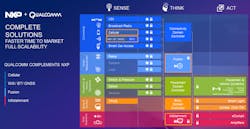NXP has a 14% slice of the automotive electronics market (Fig. 1). One reason is its wide product coverage that is not limited to automotive electronics. It holds the high ground in a range of automotive product areas including automotive analog, merchant automotive MEMS sensors, and automotive microcontrollers. These are used in infotainment, secure access, body, power train, and safety applications. NXP has plenty of competition from the likes of Infineon, Renesas, STMicroelectronics, and Texas Instruments.
Automotive is one area in the electronics arena that is expected to have significant growth potential because of the movement towards electric and self-driving vehicles. Even without these areas, the amount of electronics going into cars is growing as features like autonomous cruise control become more common. Improvements like lower cost and compact radar systems make this possible.
The forthcoming combination of NXP and Qualcomm will only improve NXP’s position in the automotive space (Fig. 2). Qualcomm’s high-end processor support isn’t just applicable to smartphones; high-performance automotive systems will benefit, as well.
One of NXP’s new offerings is the i.MX 8 family. It can include a pair of ARM 64-bit, Cortex-A72 cores along with four Cortex-A53 and two 32-bit Cortex-M4F micro cores. ARM’s TrustZone is the basis of the security features built into every i.MX 8. The camera and display support handles multiple instances of both.
High-end versions come with dual GPUs. The GPUs can be used with machine learning (ML) software. Typically one GPU would be used for display chores if the other is used for ML applications. NXP and Au Zone Technologies were showing off just such a demo at NXP FTF Connects (Fig. 3).
Au Zone’s embedded Computer Vision SDK and camera solutions work with a range of hardware, including NXP’s i.MX 8. The i.MX8 could be used with advanced driver-assistance systems (ADAS), but designers would need to turn to NXP’s BlueBox that is built around NXP’s S32V234 automotive vision/sensor fusion processor and its LS2085A embedded compute processor.
Electrobit is an NXP partner that is testing their software using NXP’s BlueBox, which is found in Electrobit’s demonstration platform (Fig. 4). Electrobit solutions range from support of the connected car to autonomous driving. Its EB Assist toolboxes address applications ranging from mapping to visualization modules.
Another concept car at NXP FTF Connects was the Rinspeed Oasis (Fig. 5). This electric car has some interesting features, like a folding steering wheel that doubles as a cup holder when in self-driving mode. There is even a garden in front with Bonsai trees. The car uses NXP electronics and has a 100 km range. The front wheels can make a tight turns simplifying parking.
The Oasis has a very large touchscreen display from Harman that supports voice and gesture control. The heads-up display on the windshield will alert the driver of obstacles.







